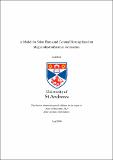Files in this item
A model for solar flares and coronal heating based on magnetohydrodynamic avalanches
Item metadata
| dc.contributor.advisor | Hood, Alan W. | |
| dc.contributor.advisor | Parnell, Clare Elizabeth | |
| dc.contributor.author | Reid, Jack | |
| dc.coverage.spatial | xii, 325 p. | en_US |
| dc.date.accessioned | 2021-02-23T15:05:31Z | |
| dc.date.available | 2021-02-23T15:05:31Z | |
| dc.date.issued | 2020-12-01 | |
| dc.identifier.uri | https://hdl.handle.net/10023/21489 | |
| dc.description.abstract | The coronal heating problem addresses how temperatures in the solar atmosphere increase by millions of degrees, moving up from the cool surface, into the upper reaches of the atmosphere. This heating, known to be attributable to the magnetic field, has attracted several possible explanations. Attention here focuses on the viability and onset of magnetohydrodynamic avalanches. One means of transferring energy from interior convective motions is through photospheric motions, for example granulation and super-granulation. The power transferred by these photospheric motions stores energy in the global coronal magnetic field, and in coronal loops within active regions. The fields become highly braided, such that an ideal kink-mode instability occurs within one strand of a loop. Then, this instability rapidly expands, destabilizing the surrounding magnetic field, and destroying neighbouring threads. Bursty events occur in an intermittent, impulsive series, Parker's so-called nanoflares, above a largely steady background. This heating is then investigated in order to determine the respective contributions of the physical mechanisms of viscosity and resistivity. Arbitrary distributions of non-uniform heating occur across the domain. The localization and impulsiveness are investigated in respect of field-aligned heating properties. These heating profiles are tested in a hydrodynamic model of single coronal strands. This heating is found capable of maintaining approximately coronal conditions. Interestingly, three-dimensional MHD simulations and field-aligned, one-dimensional models produce similar behaviours, apart from in velocity, and this may have observable consequences. Throughout, magnetic reconnection is vital in contributing to coronal heating. Therefore, the onset and locations of reconnection are identified, and compared with several possible indicators. The widely used squashing factor, Q, little agrees with the sites of reconnection in a braided MHD field. Based on these results, magnetohydrodynamic avalanches can occur and produce sufficient energy to maintain the elevated temperatures of coronal loops. | en_US |
| dc.language.iso | en | en_US |
| dc.publisher | University of St Andrews | |
| dc.subject | Sun: corona | en_US |
| dc.subject | Sun: magnetic fields | en_US |
| dc.subject | Methods: numerical | en_US |
| dc.subject | Magnetohydrodynamics (MHD) | en_US |
| dc.subject | Magnetic reconnection | en_US |
| dc.subject | The Sun | en_US |
| dc.subject | Coronal heating | en_US |
| dc.title | A model for solar flares and coronal heating based on magnetohydrodynamic avalanches | en_US |
| dc.type | Thesis | en_US |
| dc.contributor.sponsor | Carnegie Trust for the Universities of Scotland | en_US |
| dc.type.qualificationlevel | Doctoral | en_US |
| dc.type.qualificationname | PhD Doctor of Philosophy | en_US |
| dc.publisher.institution | The University of St Andrews | en_US |
| dc.identifier.doi | https://doi.org/10.17630/sta/30 |
This item appears in the following Collection(s)
Items in the St Andrews Research Repository are protected by copyright, with all rights reserved, unless otherwise indicated.

